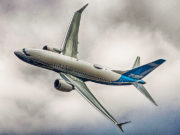Citing ongoing investigations of two Boeing 737 MAX accidents that killed 346 people, the U.S. National Transportation Safety Board (NTSB) today issued seven recommendations that call on the Federal Aviation Administration (FAA) to incorporate into its aircraft design safety assessments an evaluation of how pilots will respond to multiple alerts.
The new safety recommendations were developed through an examination of the safety assessments that were conducted as part of the original design of the maneuvering characteristics augmentation system (MCAS), which, according to preliminary investigations, activated in response to erroneous information about the airplane’s angle of attack.
All Boeing MAX airplanes have been grounded since March 13, following the March 10 crash of Ethiopian Airlines Flight 302 after takeoff from Addis Ababa. The earlier accident involved Lion Air Flight 610, which crashed after takeoff from Jakarta, Indonesia, on Oct. 29, 2018. The crashes killed all passengers and crew on both airplanes.
“We saw in these two accidents that the crews did not react in the ways Boeing and the FAA assumed they would,” said NTSB Chairman Robert Sumwalt. “Those assumptions were used in the design of the airplane and we have found a gap between the assumptions used to certify the MAX and the real-world experiences of these crews, where pilots were faced with multiple alarms and alerts at the same time.”
The NTSB’s recommendations were included in Aviation Safety Recommendation Report 19-01. In an accompanying statement, the agency said it was “concerned that the accident pilots’ responses to unintended MCAS operation were not consistent with the underlying assumptions about pilot recognition and response that were used for flight control system functional hazard assessments as part of the Boeing 737 MAX design.”
The statement added that the FAA allows such assumptions “without providing clear direction about the consideration of multiple flight-deck alerts and indications in evaluating pilot recognition and response.”
The NTSB said that, taken together, the safety recommendations to the FAA are intended to “ensure system safety assessments for the 737 MAX (and other transport-category airplanes) that used certain assumptions about pilot response to uncommanded flight control inputs, consider the effect of alerts and indications on pilot response and address any gaps in design, procedures, and/or training.”
The recommendations also call for development and use of “robust tools and methods for validating assumptions about pilot response to airplane failures as part of design certification” and “incorporate system diagnostic tools to improve the prioritization of and more clearly present failure indications to pilots to improve the timeliness and effectiveness of their response.”
The FAA said it would review all seven recommendations.
“The FAA is committed to a philosophy of continuous improvement,” the agency said. “The lessons learned from the investigations into the tragic accidents of Lion Air Flight 610 and Ethiopian Airlines Flight 302 will be a springboard to an even greater level of safety.”

